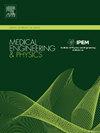热成像表征假肢使用者的皮肤适应性
IF 1.7
4区 医学
Q3 ENGINEERING, BIOMEDICAL
引用次数: 0
摘要
本研究的目的是调查使用温度峰值时间(TTP)作为表征假体使用者皮肤适应性的指标。进行了两个实验。对被试的胫骨残肢施加静压10分钟,然后使用热像仪捕捉随时间变化的温度响应。达到最高温度70%的TTP时间,在适应机械应力的位置,髌骨肌腱和前外侧远端区域(平均分别为41.5秒和47.2秒)比在肢体中部位置(127.1秒)要短。在第二个实验中,一个健全的参与者每天用毛巾擦他的下肢前近端,每天5分钟,持续11天。他在该地区的平均TTP从第1天的68.5 s下降到第11天的47.2 s。结果表明,较短的TTP反映了皮肤对机械应力的良好适应,而较长的TTP反映了皮肤对机械应力的不适应。应开展调查,确定TTP与健康结果之间的关系。本文章由计算机程序翻译,如有差异,请以英文原文为准。
Thermal imaging for characterization of skin adaptation in prosthesis users
The purpose of this research was to investigate the use of time to peak temperature (TTP) as a metric for characterizing skin adaptation in prothesis users. Two experiments were conducted. A static pressure was applied to a participant's transtibial residual limb for 10 min, then a thermal imaging camera was used to capture the time-varying temperature response. The TTP, time to reach 70 % of the maximum temperature, was shorter at locations adapted to mechanical stress, the patellar tendon and anterior lateral distal region (mean 41.5 s and 47.2 s, respectively), than at mid-limb locations (127.1 s). In the second experiment, an able-bodied participant rubbed a towel across the anterior proximal aspect of his lower limb each day for 5 min per day for 11 days. His mean TTP in the region decreased from 68.5 s at Day 1 to 47.2 s at Day 11. The results suggest that a short TTP reflects skin well adapted to mechanical stress and a long TTP reflects skin not well adapted to mechanical stress. Investigations characterizing relationships between TTP and health outcomes should be pursued.
求助全文
通过发布文献求助,成功后即可免费获取论文全文。
去求助
来源期刊

Medical Engineering & Physics
工程技术-工程:生物医学
CiteScore
4.30
自引率
4.50%
发文量
172
审稿时长
3.0 months
期刊介绍:
Medical Engineering & Physics provides a forum for the publication of the latest developments in biomedical engineering, and reflects the essential multidisciplinary nature of the subject. The journal publishes in-depth critical reviews, scientific papers and technical notes. Our focus encompasses the application of the basic principles of physics and engineering to the development of medical devices and technology, with the ultimate aim of producing improvements in the quality of health care.Topics covered include biomechanics, biomaterials, mechanobiology, rehabilitation engineering, biomedical signal processing and medical device development. Medical Engineering & Physics aims to keep both engineers and clinicians abreast of the latest applications of technology to health care.
 求助内容:
求助内容: 应助结果提醒方式:
应助结果提醒方式:


